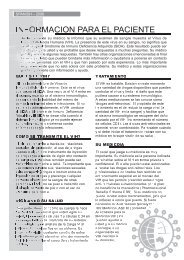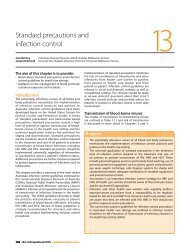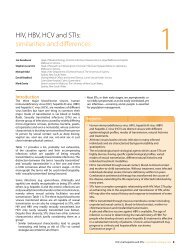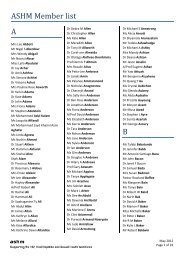B Positive – all you wanted to know about - ASHM
B Positive – all you wanted to know about - ASHM
B Positive – all you wanted to know about - ASHM
Create successful ePaper yourself
Turn your PDF publications into a flip-book with our unique Google optimized e-Paper software.
Needlestick or sharps injury<br />
prevention<br />
inappropriate handling of sharps is a major<br />
cause of accidental exposure <strong>to</strong> blood-borne<br />
viruses in health care settings. <strong>to</strong> minimise the<br />
risk of a needlestick or sharps injury, needles,<br />
sharps and clinical waste should be handled<br />
carefully at <strong>all</strong> times. specific<strong>all</strong>y, clinicians and<br />
other health care workers should:<br />
� Minimise their handling of needles, sharps<br />
and clinical waste<br />
� not bend or recap needles or remove needles<br />
from disposable syringes<br />
� use safe needle-handling systems, including<br />
rigid containers for disposal, which should<br />
be kept out of the reach of <strong>to</strong>ddlers and<br />
sm<strong>all</strong> children<br />
� Have ‘sharps’ containers available at the point<br />
of use or in close proximity <strong>to</strong> work sites <strong>to</strong><br />
aid easy and immediate disposal.<br />
importantly, the person who has used a sharp<br />
instrument or needle must be responsible for<br />
its immediate safe disposal following its use.<br />
Issues for health care workers<br />
Hepatitis B vaccination<br />
Vaccination is an important infection control<br />
strategy <strong>to</strong> prevent the transmission of HbV. a<br />
safe and effective vaccine <strong>to</strong> protect against<br />
HbV has been available in australia since<br />
1988. The Australian Immunisation Handbook<br />
(2007) 6 recommends the following groups be<br />
vaccinated against hepatitis b:<br />
� infants and <strong>you</strong>ng children<br />
� adolescents aged between 10 and 13 years<br />
� sexual contacts of people with acute and<br />
chronic hepatitis b<br />
� other household contacts of people with<br />
acute and chronic hepatitis b<br />
� People on haemodialysis, individuals with<br />
HiV and other adults with weakened immune<br />
systems<br />
� injecting drug users<br />
� recipients of certain blood products<br />
� individuals with chronic liver disease and<br />
hepatitis c<br />
� residents and staff of facilities for persons<br />
with intellectual disability<br />
� individuals adopting children from overseas<br />
� Liver transplant recipients<br />
� inmates and staff from long-term correctional<br />
facilities<br />
� Health care workers, dentists, embalmers,<br />
tat<strong>to</strong>oists and body-piercers<br />
� others at risk including:<br />
� Police, members of the armed services<br />
and emergency services staff<br />
� Long-term travellers <strong>to</strong> regions with high<br />
endemicity<br />
� staff of child day-care centres<br />
� People playing contact sport.<br />
in addition, consideration for HbV screening<br />
and vaccination should be given <strong>to</strong> people from<br />
other community groups with high prevalence<br />
of HbV infection. these include:<br />
� indigenous peoples<br />
� cultural and linguistic<strong>all</strong>y diverse<br />
communities (caLd).<br />
there is a significant variation between<br />
australian jurisdictions in the availability of<br />
funded hepatitis b vaccination programs for<br />
people considered at high risk of exposure <strong>to</strong><br />
hepatitis b infection. for further information<br />
<strong>about</strong> the availability of local HbV vaccination<br />
programs, contact relevant state and terri<strong>to</strong>ry<br />
health departments.<br />
Hepatitis B vaccination regime<br />
for adults over 20 years of age, a full course of<br />
HbV vaccine consists of three doses at 0, 1 and 6<br />
month intervals. adolescents aged between 11<br />
and 15 years should receive a two-dose regimen<br />
of the adult formulation of HbV vaccine at 0<br />
and 4<strong>–</strong>6 months intervals. it is recommended<br />
that children have a <strong>to</strong>tal of three doses of the<br />
paediatric formulation of HbV vaccine at 0, 1<br />
and 6 month intervals. infants should receive a<br />
birth dose of HbV vaccine, followed by doses at<br />
2, 4 and either 6 or 12 months.<br />
Post-vaccination serological testing is<br />
recommended four weeks after the third dose<br />
of HbV vaccine for people in the following<br />
categories:<br />
� People at significant occupational risk (e.g.<br />
clinicians and other health care workers<br />
whose work involves frequent exposure <strong>to</strong><br />
blood and body substances)<br />
b <strong>Positive</strong> <strong>–</strong> <strong>all</strong> <strong>you</strong> <strong>wanted</strong> <strong>to</strong> <strong>know</strong> <strong>about</strong> hepatitis b: a guide for primary care providers 85






